Judith Works's Blog, page 6
September 25, 2016
ACOMA: The Sky City

My friends and I began our visit in the beautiful cultural center at the base of Acoma, about an hour’s drive west of Albuquerque. The ancient settlement itself is located on a mesa 365 feet above the desert floor, a broken land dotted with other rock formations. Settled around the year 1000 AD, it is one of the oldest continually-occupied areas in the country.

Where formerly there were only ladders and steps carved into the rock, a winding road now leads up the steep hill to the cluster of adobe buildings occupied by only 30 people due to the lack of water, sewerage, and electricity. The remainder of the pueblo's citizens have opted for modernity and live nearby where there are schools, shops, and the inevitable casino.

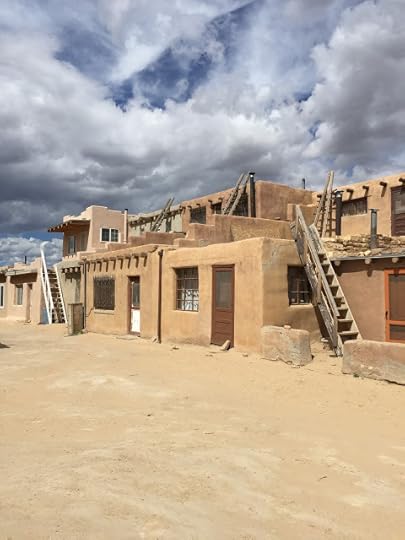
Like most of the Southwest, the Spanish arrived with their horses, guns and religion to irrevocably change the earlier culture. The mission church of San Esteban Rey, dominating the town, was founded in 1629.

The silent church has only a couple of rows of pews and is mostly used for weddings and funerals. I visualized it in the past with the priest chanting and incense wafting up to the high beams, each made from a single pine tree the Native Americans were forced to carry from the the hills thirty miles away. During their long trek they were no allowed to let the logs touch the ground even at night.
No photos are allowed, but the interior is a mix of Spanish and native décor with outlines of animals, including a bull and horse, above the side doors, and the altar brightly decorated with red and green pillars, carvings and paintings. One wall is decorated by an enormous painting donated by the King of Spain after the founding of the church. In front of the church is a walled cemetery, layered over time as a valley was filled to accommodate the dead. We looked at layer four, now reserved for dignitaries and war veterans.

The town is almost without vegetation, a lone tree beside a depression in the rock where rainwater collects stands as a sentinel.
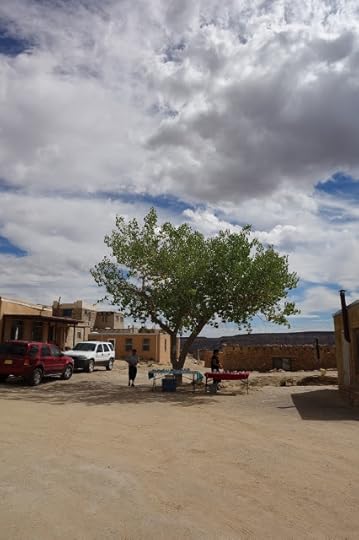
Potters displayed their work nearby. Shops in Santa Fe, with their stratospheric prices, feature the works of the most famous potters, Most are women, although I talked to one on our tour who said she was teaching her two sons. The most valuable pots are those which are totally handmade with clay that includes ground up shards - broken pieces of old pottery. Whether commercially shaped or totally by hand, all feature intricate designs in orange and black.

As we strolled, we passed two and three-story homes, some with ladders that lead to kivas, rooms traditionally used for men's religious ceremonies. One ladder had a crosspiece at the top in a cloud shape to encourage rain. Kivas are traditionally built underground, but because the ground is too hard to excavate, Acoma kivas are built on the second story of houses. Our guide, Maria, joked that they were early man caves, which made me wonder if they are actually used any more.

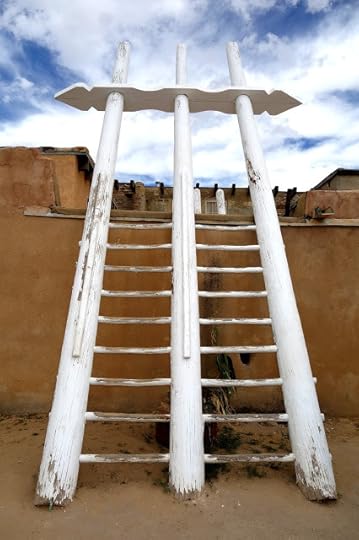
A few doors were painted to brighten the scene but the ground and the adobe buildings are all the same color, a warm tan color, making the pueblo appear as though it sprung from the earth centuries ago. A few of the homes still had the old-fashioned windows made of mica which the Spanish may have mistaken for gold when they sparkled in the sunlight.


We paused for lunch at the visitors’ center and the chef joined us to accept compliments on his latest creation: an acorn squash filled with wild rice and pine nuts, topped with grated cheese. Delicious and a recipe I'll try at home.
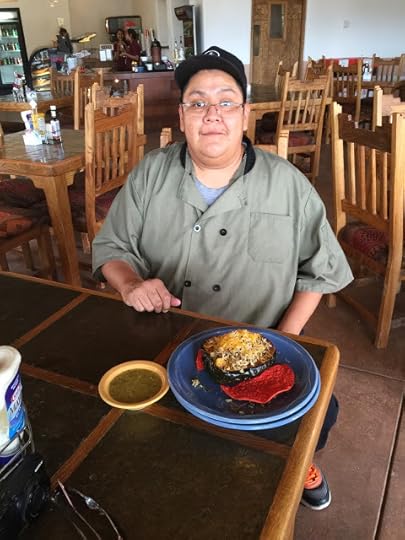
On the way back to Albuquerque, we passed a small cemetery – so sad and lonely.
.
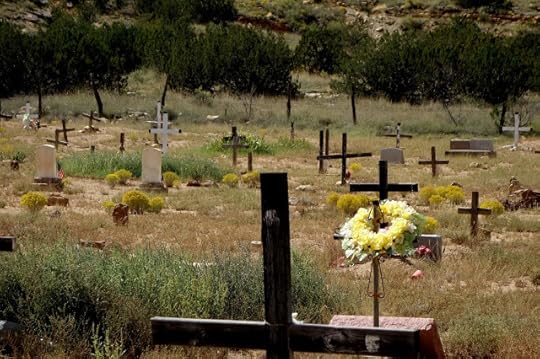
On the return trip back to Albuquerque, we took a detour to check out a white church on top of a hill at the Laguna Pueblo. The church, Mission San Jose de la Laguna, was built in 1699. As we were standing by the open front door I saw a man running toward us. Unsure if we might be trespassing, we stopped to wait. Out of breath and dripping with sweat, the man introduced himself as Arnold. He lived nearby and was a caretaker. He told us the story of the church, including some of the miracles that had happened there while empathizing that none happened at Acoma. To illustrate the continued blessing of happy events, he said his mother had recently been granted a house nearby on the reservation after many years of waiting.


As we began to move toward the exit, he brought out a wooden flute and serenaded us with a plaintive melody. Perhaps it was the same as that played in the centuries before the Spanish arrived.
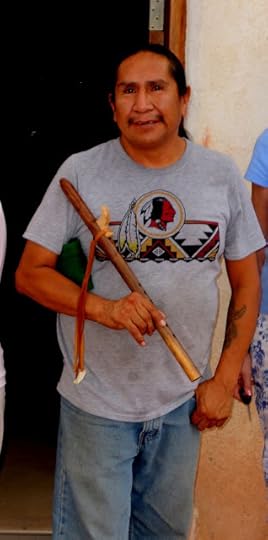
All photos copyright Judith Works
Published on September 25, 2016 10:12
August 14, 2016
IN THE KAROO
A silent young man picked us up in front of our hotel in Cape Town near a post carved with animal heads depicting four of South Africa's big game.

We climbed into an SUV for a three-hour trip to a game preserve north of the city in an area called the Karoo. As we passed the sad townships, some with small houses and others with tin shacks, we were reminded of the deep poverty that envelopes so much of South Africa.

The contrast was emphasized when we came to the lush and manicured wine country with manor houses in Dutch Colonial style and acres of vines tended by black laborers. The landscape gave way to orchard and fields of grain. Small towns were anchored with sharp-steepled churches and small shops advertising braai (barbecued meat and sausage). We stopped in the delightfully-named town of Ceres (the Roman goddess of grain) for cold drinks before starting into the vast and empty Karoo. An enormous semi-desert, it is dotted with isolated farms and sparse vegetation that springs to life in the occasional rains.
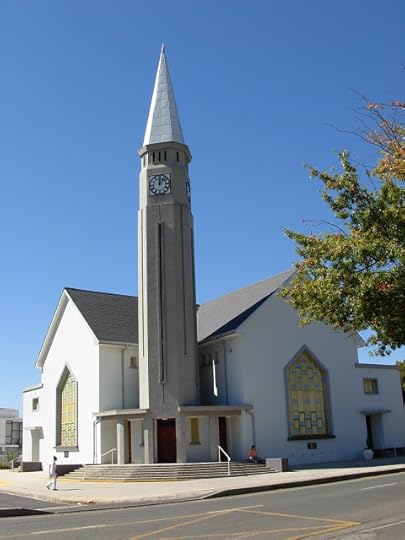
Our destination was the Inverdoorn Game Reserve where we were to spend several days on safari to see the animals. The preserve encompasses 25,000 acres of fenced land and includes a cheetah breeding operation. But it is also home to many other of Africa’s animal wealth: Cape lion, zebra, Cape buffalo, rhino and hippo, giraffes and many species of antelope.
Not long after checking in we were greeted by two cheetah cubs (on leashes) coming to visit our bungalow. They were like large kittens rubbing against us, purring with a deep rumble. We petted the coarse fur and wondering what they were thinking, hoping that it wasn’t about dinner even though we’re pretty stringy. Their handler played with them but that ended when he put his fingers too close to one cub’s mouth and found his hand trapped. Another young man coaxed the animal to open up. No damage done but as my mother said, “Keep your hands to yourself.”

At dusk we drove deep into the preserve to watch the adults being trained to hunt. The conservationist told us that they will not breed unless they are in peak condition and must be thoroughly trained to hunt before they are released into the wild if they and their progeny are to survive. A pickup truck dragged a dead chicken on a long wire with the animals racing after it. The winner got the spoils and the others had to wait for the next run. They can run up to 70 miles an hour in short bursts - a spotted blur in the evening gloom.

The following day a group of day tourists arrived for lunch. Several rambunctious children were in the group and when the cubs were brought out they lunged at the children, more of a bite-size meal than us. Wild animals they were and I was content to admire them from a distance.
Although our room was luxurious and it was tempting to lounge around the pool, the attraction of the animals got me up before down, ready with camera and binoculars. The animals were so close that I didn’t even need a telephoto lens.

Rhinos and Cape buffalo, looking oblivious to our “ohs” and “aws” strolled to a waterhole, zebras cavorted, and giraffes trotted by with their rocking gaits. The low light cast a golden glow over the scene.

The homely gnus grazed but other large antelopes were stately as they looked at us curiously before moving slowly off into the brush in a dignified manner. The smaller antelope like springbok bounded around like hyperactive ten-year-olds. One apparently didn’t jump fast enough when on a morning game search we saw blood on the trail, the remains of a partially-eaten carcass and a leopard print. The leopard had leaped over the fence for a meal and was long gone but would return that night.

The Cape lions, apparently extinct in the wild, were in a separate enclosure, the only zoo-like aspect of the game preserve. The guide opened both gates and we drove in. She closed the gates and turned the key in the ignition. It wouldn’t start. There we were like a pair of Daniels in the lions’ den. A tense few minutes followed while she radioed for backup. Fortunately they weren’t hungry. While we waited for help, we watched as the black-maned male mated with one female while the others in the pride napped in the shade of a few trees in the hot afternoon, uninterested in the coupling next to them.

It was hard not to think of all the wildlife being slaughtered without care throughout the continent. A tragedy for them and for us. We felt fortunate to have a small chance to see what is left outside the national parks, too far away for us on this journey.
We were reluctant to leave. The same driver came to pick us up for the journey back to Cape Town. This time he was conversational, telling us about his life. He was a migrant from the Congo. Economic migrants are bitterly, sometimes violently, resented by South Africans who are desperate for jobs. He was trying to support a family in his home country but said the pay was so low it was nearly impossible to sustain himself and them, and that he suffered constant discrimination. It seemed to us that not only were the animals under siege, but also the people of every country in the region, all seeking work no matter where the quest led them.
We took a different route than the outgoing trip, this time over craggy and mostly barren steep hills. Proteus, the national flower of South Africa, bloomed in crevices. At the summit we came upon a troop of baboons, dangerous to people and destructive to crops, preventing us from getting out of the SUV to enjoy the view. We descended and reached Ceres again where a long line of angry-looking agricultural workers marched along the roadway holding signs, some in Afrikaans and others in English. Low wages and not enough work – the universal problem.

We stopped at a coffee shop before we reached the city’s outskirts and convinced the driver to join us for a snack. He reluctantly did so, silently drinking a Coke and eating a sandwich. The other patrons stared at him. It was clear that he was accepted by neither whites nor blacks, caught in a harsh world of great beauty that offered him little.
How sheltered we were from reality again when we said good-bye and entered the enclosed world of a fancy hotel on the Cape Town waterfront, far removed from others’ problems, both animal and human.
Published on August 14, 2016 11:47
July 17, 2016
SOUNDSCAPE - BAMAKO, MALI
A guest post from my fellow travel writer, Tori Peterson, writer and adventurer. She is currently working on a memoir about living in Mali and Rwanda. Her last travels including walking the Camino de Santiago and trekking in the high Andes.
When I left the United States for the first time, I was 30 years old. Yes, I knew that I would be seeing new sights and new cultures, but I did not stop to think how my senses would be surprised, assaulted, and challenged. Touch, in the form of heat, and smells hit me first. Like music in a movie, sound was always there in the background.

I traveled to Bamako, Mali, West Africa to live for three years with my husband and four children, 10 months to eight years old. Our flight landed in Dakar, Senegal. Late October is not the hot season, but a wall of heat hit me in the face as I walked down the stairs from the plane to the tarmac. After the heat I was aware of the smell. My offended nose could not pick out the different vegetation and animal odors grilled by the sun producing a heavy earthy fragrance. Here we would catch our flight to Mali.

In Bamako, I felt I had been transported and dropped on the other side of the moon. As I waited for our house to be Americanized, I met new sights, smells, tastes, and sounds. Sounds, always in the background, slowly crept into my consciousness.

The constant whirring songs of early evening insects. Walking the dry, dusty streets, Malians greeted me in French, “Ca va.” At the Grand Marche and small grocery stores, beggars without fingers or feet, demanded, “Cadeau.” The call of vegetable women, “Madam, Madam,” as they stopped by my gate to sell their papayas, mangos, and spinach to me.

That first morning in our home, roosters crowed. Dogs barked. Noise invaded my sleep. A donkey’s bray joined the cacophony. The air filled with electrical scratches while a man’s static, garbled voice chanted. Into our bedroom paraded three of our four children, the oldest asked, “Daddy, Mommy, what is that man doing to the animals?” My husband sleepily replied, “The muezzin at the mosque is calling the faithful to prayer.”
Several mornings later I heard a soft thump, thump, thump and chanting to the beat. Walking out of my walled in yard down the pot-holed dirt road, I discovered the source of the music. Two women dressed in blue, white, and green tie-dye boubous lifted and lowered long wooden pestles smacking millet in a two foot high wooden mortar. The grain cushioned the pestle as it hit the bottom of the mortar. Their song accompanied the rhythm of the lifting and lowering.

This unique soundscape become familiar and part of my mornings. As I travel, I am still surprised by unexpected sounds. They have woven their way into my memory and stories of places lived and visited. Becoming aware of the snorting of hippos bobbing in the Niger River, wind in bells, drums, and chants from temples, the clickety-clack of trains, muezzin’s call to prayer, bird songs, the cadence and tones of languages enriched my travel experience and my life.
Photo of women pounding millet by Kaia Chessen, a medical illustrator in global health. See more of her photography and illustrations at http://www.kaiachessen.com/personal/#/travel-photography/.
All other photos from Wikipedia Creative Commons licenses
Published on July 17, 2016 06:43
May 29, 2016
ON HEARING FADO IN LISBON
I'm pleased to have a guest post from travel writer Vivian Murray, a member of EPIC Group Writers based in Edmonds, Washington.
ON HEARING FADO IN LISBON

The apartment was a short-term rental through VRBO and located on a hill in the Alfama, one of the oldest districts in Lisbon, Portugal. We were on the 3rd (or 4th depending on what country you were in) floor requiring careful negotiation of a narrow wooden stairway which seemed endless at the close of a long day. My bedroom included a balcony facing a narrow cobbled street where the old yellow trolley cars clanged up and down. On our first morning, my 4 year old granddaughter and I happened to catch a random parade, featuring historically dressed soldiers on white horses, as it passed by. It was perfect.
Portugal is known for port wine, gorgeous tilework (azulejo), and fado (a Portuguese style of music). Hearing fado was the last item on my ‘must do’ list and the clock was ticking to hear live fado music before flying back home to the States.

One evening, I stopped by a neighborhood restaurant up the hill from our apartment advertising fado in scrolled writing on a small sign in the window. I asked the doorman if I could come in for a glass of wine to listen. He apologetically told me this was only possible if I reserved a table for dinner. Recognizing this was an upscale restaurant, I knew we would not have a relaxed meal with my 4 year old granddaughter in tow and I did not make a reservation.
When at a flea market on another day, I was told about a fado club a few miles away. But before I went through the bother, I decided on my last day in Lisbon to purposely ‘dress up’ for dinner, although we were only going to the family restaurant downstairs.
Donning black pants, white shirt, a pretty new scarf from Tangier, uncomplicated makeup with a dash of mascara, along with a bit of simple jewelry, I managed to spark up my tired-looking-traveler-appearance. This was my secret tactic to get inside the neighborhood fado restaurant before heading to the fado club.
After dinner, my family returned upstairs to pack, and I ventured back up the hill.Walking past the tall restaurant windows, which were covered with white gauze curtains, I approached the same door and same host from a few days prior. Again I inquired, “Would you mind if I purchased a glass of wine or two while listening to your music?” Without hesitation, in his halting English, he politely asked me to wait a moment while he checked with the owner. My strategy worked!
After a short wait, a crisply-attired maître d’ ushered me into a long narrow room filled with an ambience of quiet elegance. The dining room glowed with candle lit tables swathed in white linen with crystal chandeliers hanging in delicate balance above. The maître d’ seated me a couple of tables back from the stage with a perfect view of the musician.
Casually scanning the softly flickering room, I noted only two couples dining separately, and one lone man at a table in the very front of the room. His table held three white candles sitting tall in a large crystal goblet of white sand. It was obviously an extremely slow evening in the maybe 40 capacity restaurant. No wonder they let me in.
A male performer played guitar and sang melancholy songs like “Bridge Over Troubled Waters”, which was definitely not fado. One couple left soon after I arrived and the other couple stayed for a few more songs while entertaining the staff with stories about riding their bicycles from Amsterdam to Portugal.

On my second glass of wine, I soon became the only customer, other than the man up front and an older gentleman who arrived during intermission sitting very still by the front door with the beer he was served in hand. Perhaps he was also a neighborhood interloper who wanted to hear fado without purchasing an expensive dinner?
With no other diners, the young server and I had an enjoyable conversation about life, family, and travels. His English was very good and it was quite sweet to hear him talk about his young family and the life they dreamed of living. There was no fado, but I was relaxed and content.Curious about the man at the table up front, I observed he was dressed extravagantly and the servers deferred to him by keeping his wine and water glasses full. They were very polite and soft-spoken when around this man; they seemed to almost bow. Candlelight flickered shadows across his rigid profile and even in the dim light I could see he wore a long lapis-blue satin jacket, brown leather pants, and handmade yellow-leather-pointed shoes peeking from beneath the tablecloth. My waiter let me know this was the restaurant owner.
The intermission concluded and the guitarist returned to the stage again but this time the quiet older gentleman near the front door slowly stood, placed his beer glass on the chair, and positioned his robust figure in front of the stage facing sideways toward the long, empty region of the room. Wearing a plain zippered jacket over a simple striped shirt, he appeared to be a working man rather than a performer. Clearing his throat and closing his eyes, he began to sing.Guitar chords thrummed along as his rich baritone voice crooned melodies, which even in my limited experience, I immediately recognized as fado. This was the deeply rooted Portuguese music I was seeking
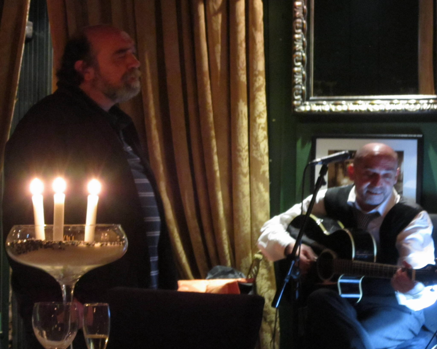
I couldn’t understand a word of the lyrics but there was such fervor in his delivery, I imagined the songs could only be of love and loss. This was the passion of soulful and sultry fado I was seeking.
https://www.youtube.com/watch?v=Ez0hhwUD4wA
The performance ended and reluctantly I made my way to the front door stopping next to the owner. I thanked him and then asked if he’d like me to send him photos of the evening and he gladly gave me his card. Voicing my appreciation to the entertainers and servers, I said, “Obrigada” (“Thank you” in Portuguese using the female tense) and they applauded me while replying “Obrigado” in the male tense as if pleased that I knew the difference.
Outside in the dark, encased in a foggy drizzle, I gingerly navigated damp uneven cobblestones until finally arriving at our apartment building door. Slipping in the old skeleton key into the ancient iron lock and pushing open the heavy wooden door, without a second thought I bounded up the 3 flights of stairs using a new-found gait never experienced during the previous days of climbing those wretched steps.
In my experience, music is truly an elixir for the body and soul and when traveling, hearing local music in foreign countries offers an experience travelers should write on their ‘must do’ list. It’s even worth dressing up a little for the event.

Photo Credits:
Blue Tiles: Alvesgaspar, Wikipedia CC
Plaza in Lisbon: Lee Canon. Wikipedia CC
Painting of Fado Musician: Joes Malhoa, 1910, Public Domain
Fado Singer: Vivian Murray. copyright Vivian Murray
Alfama Sreecar: Romazur: Wikipedia CC
ON HEARING FADO IN LISBON

The apartment was a short-term rental through VRBO and located on a hill in the Alfama, one of the oldest districts in Lisbon, Portugal. We were on the 3rd (or 4th depending on what country you were in) floor requiring careful negotiation of a narrow wooden stairway which seemed endless at the close of a long day. My bedroom included a balcony facing a narrow cobbled street where the old yellow trolley cars clanged up and down. On our first morning, my 4 year old granddaughter and I happened to catch a random parade, featuring historically dressed soldiers on white horses, as it passed by. It was perfect.
Portugal is known for port wine, gorgeous tilework (azulejo), and fado (a Portuguese style of music). Hearing fado was the last item on my ‘must do’ list and the clock was ticking to hear live fado music before flying back home to the States.

One evening, I stopped by a neighborhood restaurant up the hill from our apartment advertising fado in scrolled writing on a small sign in the window. I asked the doorman if I could come in for a glass of wine to listen. He apologetically told me this was only possible if I reserved a table for dinner. Recognizing this was an upscale restaurant, I knew we would not have a relaxed meal with my 4 year old granddaughter in tow and I did not make a reservation.
When at a flea market on another day, I was told about a fado club a few miles away. But before I went through the bother, I decided on my last day in Lisbon to purposely ‘dress up’ for dinner, although we were only going to the family restaurant downstairs.
Donning black pants, white shirt, a pretty new scarf from Tangier, uncomplicated makeup with a dash of mascara, along with a bit of simple jewelry, I managed to spark up my tired-looking-traveler-appearance. This was my secret tactic to get inside the neighborhood fado restaurant before heading to the fado club.
After dinner, my family returned upstairs to pack, and I ventured back up the hill.Walking past the tall restaurant windows, which were covered with white gauze curtains, I approached the same door and same host from a few days prior. Again I inquired, “Would you mind if I purchased a glass of wine or two while listening to your music?” Without hesitation, in his halting English, he politely asked me to wait a moment while he checked with the owner. My strategy worked!
After a short wait, a crisply-attired maître d’ ushered me into a long narrow room filled with an ambience of quiet elegance. The dining room glowed with candle lit tables swathed in white linen with crystal chandeliers hanging in delicate balance above. The maître d’ seated me a couple of tables back from the stage with a perfect view of the musician.
Casually scanning the softly flickering room, I noted only two couples dining separately, and one lone man at a table in the very front of the room. His table held three white candles sitting tall in a large crystal goblet of white sand. It was obviously an extremely slow evening in the maybe 40 capacity restaurant. No wonder they let me in.
A male performer played guitar and sang melancholy songs like “Bridge Over Troubled Waters”, which was definitely not fado. One couple left soon after I arrived and the other couple stayed for a few more songs while entertaining the staff with stories about riding their bicycles from Amsterdam to Portugal.

On my second glass of wine, I soon became the only customer, other than the man up front and an older gentleman who arrived during intermission sitting very still by the front door with the beer he was served in hand. Perhaps he was also a neighborhood interloper who wanted to hear fado without purchasing an expensive dinner?
With no other diners, the young server and I had an enjoyable conversation about life, family, and travels. His English was very good and it was quite sweet to hear him talk about his young family and the life they dreamed of living. There was no fado, but I was relaxed and content.Curious about the man at the table up front, I observed he was dressed extravagantly and the servers deferred to him by keeping his wine and water glasses full. They were very polite and soft-spoken when around this man; they seemed to almost bow. Candlelight flickered shadows across his rigid profile and even in the dim light I could see he wore a long lapis-blue satin jacket, brown leather pants, and handmade yellow-leather-pointed shoes peeking from beneath the tablecloth. My waiter let me know this was the restaurant owner.
The intermission concluded and the guitarist returned to the stage again but this time the quiet older gentleman near the front door slowly stood, placed his beer glass on the chair, and positioned his robust figure in front of the stage facing sideways toward the long, empty region of the room. Wearing a plain zippered jacket over a simple striped shirt, he appeared to be a working man rather than a performer. Clearing his throat and closing his eyes, he began to sing.Guitar chords thrummed along as his rich baritone voice crooned melodies, which even in my limited experience, I immediately recognized as fado. This was the deeply rooted Portuguese music I was seeking

I couldn’t understand a word of the lyrics but there was such fervor in his delivery, I imagined the songs could only be of love and loss. This was the passion of soulful and sultry fado I was seeking.
https://www.youtube.com/watch?v=Ez0hhwUD4wA
The performance ended and reluctantly I made my way to the front door stopping next to the owner. I thanked him and then asked if he’d like me to send him photos of the evening and he gladly gave me his card. Voicing my appreciation to the entertainers and servers, I said, “Obrigada” (“Thank you” in Portuguese using the female tense) and they applauded me while replying “Obrigado” in the male tense as if pleased that I knew the difference.
Outside in the dark, encased in a foggy drizzle, I gingerly navigated damp uneven cobblestones until finally arriving at our apartment building door. Slipping in the old skeleton key into the ancient iron lock and pushing open the heavy wooden door, without a second thought I bounded up the 3 flights of stairs using a new-found gait never experienced during the previous days of climbing those wretched steps.
In my experience, music is truly an elixir for the body and soul and when traveling, hearing local music in foreign countries offers an experience travelers should write on their ‘must do’ list. It’s even worth dressing up a little for the event.

Photo Credits:
Blue Tiles: Alvesgaspar, Wikipedia CC
Plaza in Lisbon: Lee Canon. Wikipedia CC
Painting of Fado Musician: Joes Malhoa, 1910, Public Domain
Fado Singer: Vivian Murray. copyright Vivian Murray
Alfama Sreecar: Romazur: Wikipedia CC
Published on May 29, 2016 10:43
February 16, 2016
AGRIGENTO AND THE VALLEY OF THE TEMPLES

The other day I read that the almond trees in Agrigento were in blossom and my thoughts returned to the marvelous archeological zone near the city called the Valley of the Temples. The name always struck me as odd because the famous Greek temples are high on a ridge overlooking the sea a few miles away. But there are temples galore.
The almond blossoms had fallen by the end of May last year when we were there and the trees were laden with green almonds.

Ancient contorted olives trees add to the beauty of the scene.

The area was settled by Greeks around 580 B.C. and followed the same pattern of conquest and culture as most locations in the area: Romans, Byzantines, Arabs, Normans and the rest. The Greek temple builders named it Akragas. The name changed over time until 1927 when Mussolini decided that it should be Agrigento.
We began our walk at the top of the hill on a hot day to traverse the Via Sacra which parallels the remains of the original city walls, honeycombed in places with the remains of Byzantine tombs.

The first golden-hued temple is the Temple of Hera of which not much remains but lonely pillars reaching toward the sun.

Next is the magnificent Temple of Concord, the best preserved of all Greek temples outside of one in Athens. It was supposedly named Concord in honor of couples who came to worship on their wedding day to ensure a peaceful marriage. The temple owes its state of preservation to the oddly named 6th century bishop of Agrigento, Saint Gregory of the Turnips, and was only restored in the 18thcentury. I thought the tourists should be wearing Greek-style clothing like those on painted vases to complete the picture.

Nearby, a bronze statue of Icarus by Igor Mitoraj lies on the ground as if he had just tumbled from the sky when the sun melted the wax that held his wings together. Beware of flying too close to the sun as his father, Daedalus, the legendary founder of Akragas, warned. The statue seems a perfect foil to the temples, stripped bare of their ornamentation but still standing defiant after 2500 years while the heedless Icarus died. What buildings of our day will last that long or will some of ours fall to earth for failure to heed warnings?

The nearby Villa Aurea has a memorial to a Captain Alexander Hardcastle in the courtyard. He showed up in 1921 to provided money for excavations in the area and restored the villa as his home. He lived there with his brother until he went broke and died in an insane asylum. The villa is now used for exhibitions but I dreamed of living there in the midst of all this beauty.

The Temple of Herakles is a heap of enormous building blocks, and following that is the remains of the Temple of Olympian Zeus, once the largest Doric-style temple in the Greek world. Not much is left but a few columns and a gigantic statue (telemone), one of many that once stood along the sides of the building. All but this one and one in the museum, now swept away by time and history.

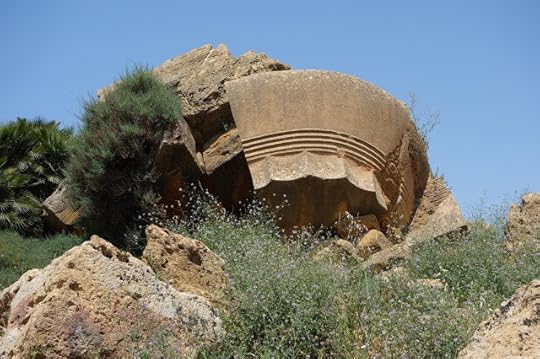

As we left the Via Sacra portions of a temple called Castor and Pollux shimmered in the sun. The only guard was a sleeping dog.

The "temple" was in fact erected in 1836 from leftovers, and despite its unauthentic provenance, it is the perfect vision of the romanticism of the Classical world. and the symbol of the city.

The wonderful archeological museum contains the finds from the temples along with finely painted Greek vases, statuary and marvels from the Romans and Byzantines who all had their day in the sun but ultimately fell to earth.



All photographs copyright Judith Works
Published on February 16, 2016 11:34
December 13, 2015
SALT FROM THE SEA
We returned from our travels to Sicily, not with salt of the earth but salt from the sea. But we began the visit to the far western part of the island in the, tiny walled town of Erice 2500 feet above the salty sea. The town was founded by about 1200 BC but developed by the Carthaginians around the 6th Century BC. After which its history followed that of the rest of Sicily with one culture after another taking over. Now it's nearly deserted in the winter when snow falls, but filled during the warmer months with tourists, mainly those from elsewhere on the island who come in the summer to escape the heat.

Long ago, it was known all over the Mediterranean for its temple dedicated to the goddess of fertility known as Astarte, Aphrodite, or Venus to the Romans who supported it with taxes. The cult was bound with sacred prostitutes who, as the story goes, began their “careers” at age 13 and retired at 21. They dined on milk and honey to become pleasingly plump and were much in demand as wives after they left the temple.

We didn’t eat any milk or honey nor was there anything much to see of the temple, but we made the modern obligatory and fattening stop at the justly famous Pasticceria di Grammatico Maria, who use the same recipes and ingredients as those of cloistered nuns in the 1400s. We didn’t resist the enticements like “sighs,” “beauty-ugly,” “mother- in-law’s tongue,” and the inevitable cannoli. All divine. I could visualize myself becoming pleasingly plump if we hung around too long.

On a sugar high from the pastries and a couple shots of espresso, we headed down (way) down to the salt pans near Trapani, The city was founded at the same time as Erice and served as its port in ancient times.

Beyond the city lie the salt pans near an area interestingly called Nubia. We wondered if the name was a coincidence or from Africans who settled in the area at some point. The area is now mostly a nature reserve with flamingos and herons, the salt trade having declined over the years.

The ponds are filled with sea water in late winter, and the winds and sun slowly evaporate the water until the crystals become reddish from algae. When the algae dies the salt is at the correct salinity to be harvested. It's then washed and raked into piles to drain before packaging.

In the distance we could see an old watchtower, a relic of the days when the Saracens raided.

Despite the overdose of pastries we didn't want to miss lunch, so we stopped at the Trattoria del Sale (sale is Italian for salt), a restaurant surrounded by the salt works. The food was good but the museum associated with the restaurant was fascinating.
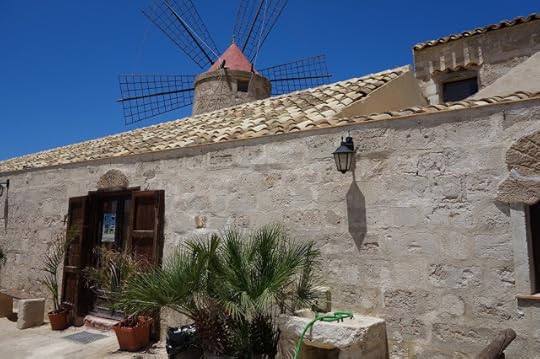
Windmills were built in medieval times to help pump the sea water, but judging by the museum the process must have been beyond backbreaking until recent times when machinery came into use.

Between courses we looked at the salt-encrusted wood Archimedes screws to pump water, a frame for a windmill sail, and the rakes and wagons, and wondered how the workers survived such labor in the burning sun while here we were relaxing with food and wine without a care.

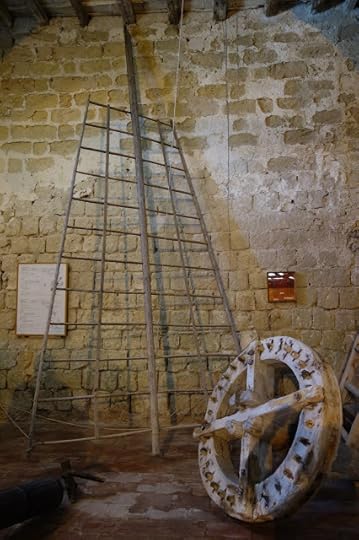
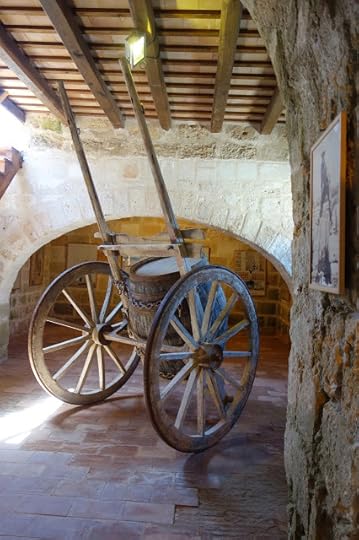
It's strange that so many places of past misery are now tourist attractions where the traveler can take a quick look, contemplate for a few minutes, and then ponder the next meal. Especially in Italy.

All photos copyright Judith Works
Published on December 13, 2015 14:28
November 9, 2015
THE DELIGHTS OF TAORMINA

What a delight! The small town perched high on a hill above the Ionian Sea in the shadow of snow-dusted Mt. Etna is just right for walking. And of course shopping and eating. This visit we were on a day trip to take another look at the marvelous Greek theater and stroll the streets to visit gardens, Roman ruins and medieval buildings. And of course do some shopping. The narrow and winding road from the seaside to the town winds around lovely homes, small plots with vines and citrus, and luxury hotels until it reaches the parking lot. From then on it’s time to stroll on the cobblestones licking a cone of gelato and oogling the mouth-watering marzipan treats in bakeries and bars, and sampling the luscious Sicilian citrus.


Like almost every town in Italy Taormina has a long history, in this case, really long. It was founded by the Greeks in 392 BC and they pushed even earlier inhabitants out. Of course the Romans came along and then everyone else who has tramped through Sicily. In more recent times Kaiser Wilhelm II decided to winter there in the 1890s and other royals and their hangers-on soon followed. Some of these men were overly interested in the local population and one impoverished baron made a living photographing doe-eyed youths with their water jugs and baskets or in togas with flowers in their hair often in mildly erotic poses. Others went straight for pornographic. After World War II, Taormina was rediscovered and the rich and famous flocked there. Truman Capote, Winston Churchill, Orson Wells, Cary Grant and the off and on-again duo Elizabeth and Richard honeymooned there - twice.
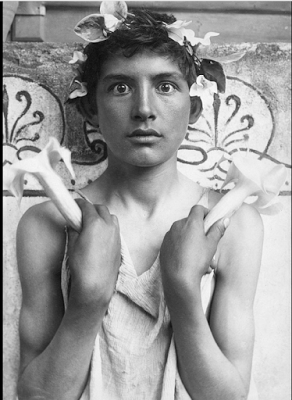
The first item on our agenda was to return to the marvelous Greek theater where the ancients sat watching plays performed as part of their religious rites. What is most visible today is Roman reconstruction; instead of plays they had gladiator competitions. The acoustics are so good that the theater is now used as a venue for concerts and big names regularly appear there in the summer.

The central gathering point for the inhabitants and tourists is the Piazzale IX Aprile an ideal spot for an iced coffee before visiting the lovely public gardens. Massimo, the postman was taking a break too.



The gardens, full of subtropical plants were created in 1899 by a civic-minded Englishwoman, Florence Trevelyan Cacciola. In true English style there are follies and fountains and benches to rest in the shade. And, as always in Italy, there is a monument to the town’s dead in the World Wars. On a happier note we watched a photo shoot with Miss Sicily who my husband said looked like a winner to him.



Footsore, we headed back down the main shopping street, the Corso Umberto, with its tempting shops, flower-filled balconies and medieval alleys to the Odeon, a small Roman theater incorporating earlier Greek elements.

There’s not much there now and it is incongruously abutting the back of a 17th century church.

Far more interesting is the Palazzo Corvaja which combines a 10th century Arab structure and a 15th century Catalan Gothic design. Inside the building is a museum with traditional Sicilian handicrafts including puppets.


The mix of Baroque church, Greek/Roman theater, and Arab/medieval design all within a few paces of each other encapsulates the flavor of the town.
All photos except the young man are copyright Judith Works. The photo of the young man taken about 1900 is from Wikipedia
.
Published on November 09, 2015 11:18
October 15, 2015
PORT TOWNSEND
Whenever we want a quick getaway from the hustle of Seattle we hop on the ferry to cross Puget Sound and head up the Kitsap Peninsula to the serenity of Port Townsend, a small city located near the entrance to Admiralty Inlet, the main shipping channel to Seattle and Tacoma.
After coffee in Port Gamble on our latest journey we took a detour before reaching our goal by following a wild turkey in the bicycle lane. It was striding along in a determined manner toward the junction to Marrowstone Island just south of Port Townsend. Nordland, the "capital," would be a good place for lunch (not turkey sandwiches), but we found the town consists of a general store combined with a post office boasting a sign about a nude beach. If you want rural this is your ideal location.


Not wanting to expose our delicate bodies on a cool day we turned back to the main road and lunch in one of the many good restaurants waiting for us. One of my favorites is Sweet Laurette, a funky cafe/bistro where you can sit outside. It was market day next to the bistro so of course we loaded up with fresh produce for snacks.

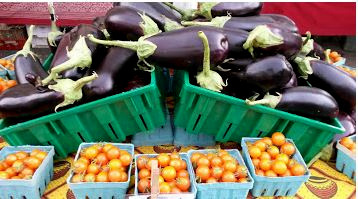
Port Townsend is full of interesting shops, bookstores, restaurants and water-oriented activities. Fort Warden State Park is ideal for walking along the beach when the fog is lifting to see the Point Wilson lighthouse first erected in 1878 as a wooden tower and later replaced with its current iconic shape,

or visiting the two small museums devoted to marine environments.

One hidden gem located near the massive Civil War-era parade ground at the fort is the famous Copper Canyon Press where some of the country's best poetry is published. They have a small bookstore if you are in the mood for shopping after your beach walk.
My other favorite bookstore is Insatiables which is full of weird and wonderful old books. Original editions and offbeat oldies cram the shelves. I could not resist What a Woman of 45 Ought to Know by Mrs. Emma Drake M.D. part of the “Self and Sex Series.” It was published in 1902. I think the good doctor would die of a stroke if she could see us now. Lars Porsena or the Future of Swearing by Robert Graves, 1927, was my other choice before my husband grabbed my wallet to prevent further crazed shopping. The book is part of a series all with Latin names published in England during the period. I wonder what Lysistrata, or Woman’s Future and the Future Woman would have to say. Or Pegasus, or the Problems of Transport. Maybe they will be waiting for me on the next visit.

Besides bookstores, the Victorian-era downtown area (a National Historic Landmark District) has sidewalk entertainment, flower-decked windows, and art - lots of art.


This window shows an entry into a wearable art competition - a winner as far as I was concerned. I especially like the bread wrapper and closures used as decoration around the over skirt and sleeves:

A stroll on the town's waterfront, a block from the main street shows another side of Port Townsend: that of a marine-oriented city.

And, reminiscent of Boys in the Boat, crew is also popular with the shells stored in a new facility adjacent to the boat building workshop.


By the time our first day was nearing afternoon-tea (or drinks) time, we checked in to my favorite hostelry: Ravenscroft Inn, where I could happily stay and write for weeks on end in their lovely rooms.



We’ll be back soon.
All photos, except the exterior of the Ravenscroft Inn, copyright Judith Works
Exterior of Ravenscroft Inn, copyright Ravenscroft Inn, used courtesy of innkeeper
Published on October 15, 2015 11:12
September 20, 2015
BETWEEN SCYLLA AND CHARYBDIS - THE STRAIT OF MESSINA
We arrived in Sicily deep in the bowels of the large ferry that transports the train from the mainland to the island. Now we returned for a day of sightseeing, this time on one of the many car ferries that cross the straits from Messina back to the port near Reggio Calabria.
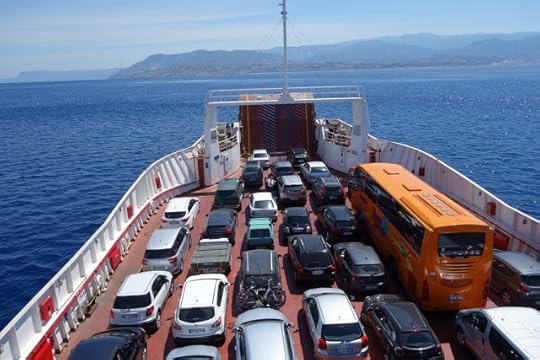
The straits, so feared by the ancients, are only two miles wide at this point but are still full of hazards: cargo and cruise ships moving at high speed day and night, along with strong tides as the waters flow back and forth between the Ionian and Tyrrhenian Seas. But we didn’t see any terrified ancient Greeks or Romans rowing frantically while on the lookout for Scylla, the mythical monster, a rock shoal on the mainland side, or Charybdis, a terrifying whirlpool off the Sicilian coast. Both these monsters were said to be women; Scylla had 12 arms and 6 heads on long snaky necks; Charybdis belched water three times in an out. Homer says Odysseus decided to steer closer to Scylla and lose a few sailors rather than chance going near the whirlpool and risk losing the whole ship.
The memories of the ancients live on: Our first stop after disembarking was the small town of Scilla, Now topped by Castle Ruffo, the fearful rock named Scylla still looms over the little seaside town. But as in Sicily, none of the women looked at all like the myths and I wondered why the ancients determined they were women.

No one we saw looked terrified either. In fact, the town was quiet and nearly empty with only a couple of restaurants and bars open and a few sunbathers trying out the early summer sun.

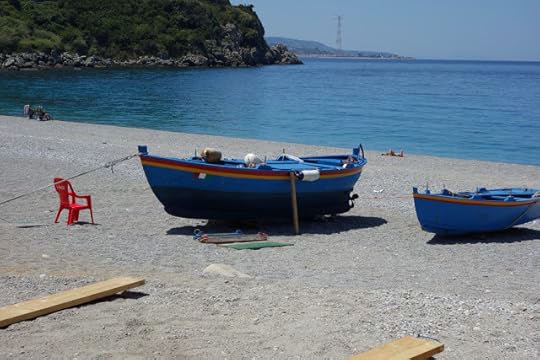

We watched several workers painting and scraping to get everything cleaned up for the coming high season. Others set up two cabins, one with a truly bizarre logo on the side: a man trying to look over a barrier to watch women changing their clothes. Not very inviting to me.

The only other sign of life beyond the few workers and the restaurant and bar next door where we had lunch and coffee was a sword fishing boat, the lookout swaying back and forth high atop the mast. No a job for those prone to seasickness.

The meal was excellent but there was no point in lingering after we enjoyed an iced coffee while looking far out to sea where the distant shapes of the Aeolian Islands shimmered in the haze.
Our goal for the afternoon was the famous Riace Bronzes now in a museum in Reggio di Calabria, at the end of Italy’s boot. The unfinished museum is still nearly empty after years of construction. All we saw besides the bronzes was a small gift shop, and a large hall with three sculptures at the far end.
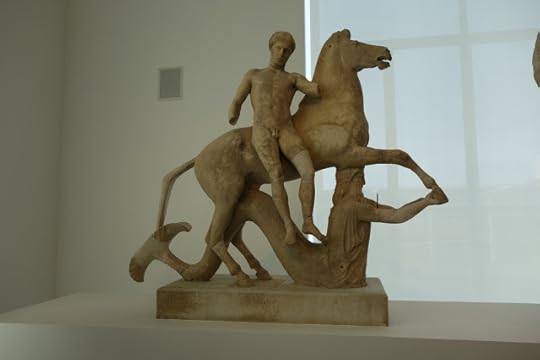
A separate climate-controlled room houses the two bronzes plus three bronze heads all set on high-tech earthquake proof pedestals. Tourists are let in in groups of about twenty after a wait in a decontamination room designed to clean the air. We waited our turn behind a group of giggling grade schoolers in their matching outfits.

The museum, empty though it is, was more than worth the journey. The two Greek bronzes were found by chance in 1972 when a snorkeler noticed an arm sticking out of the sand. Not some poor drowned soul but a statue. The second one turned up nearby. They are an astounding example of workmanship. Most likely cast around 450 BC, the larger than life-size figures probably represent two warriors, one a young hero or god conscious of his own beauty and power, and an older more mature hero with a relaxed pose.
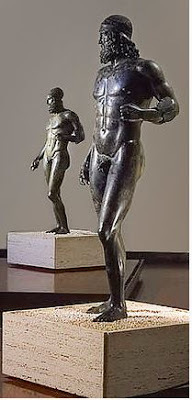
The eyes are calcite, their teeth silver, lips and nipples are copper. It is unknown exactly where they came from. One theory holds that they were plunder when the Romans occupied Greece and then were lost in a shipwreck on the way to some emperor's villa or palace, although no ship remains have yet been found. Wherever they came from they are worth a visit to southern Italy and a stunning reminder of the skills of the ancient Greeks who didn’t need computer programs to produce masterpieces unequaled until the Renaissance.


Back on Sicily, our day of marvels was completed with Mt. Etna spilling fire while we dined at a small seaside restaurant. Nature and man combined to produce an unforgettable experience.
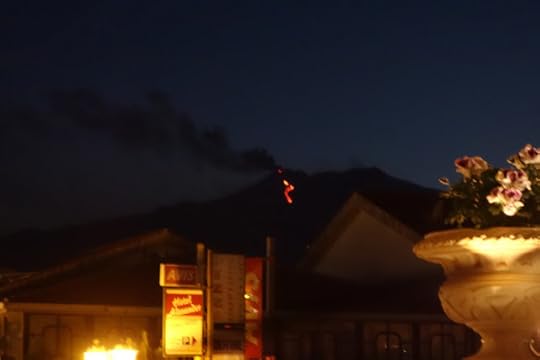
All photos copywrite the author with the exception of the two statues in one photo which are from Wikipedia
Published on September 20, 2015 15:53
July 31, 2015
STRANGERS ON A TRAIN
The Rome airport was in chaos because of a fire. Our one-hour flight to Catania in Sicily, where Glenn and I were to begin a two-week tour, was cancelled and we were unable to rebook by computer or in person. Our only alternative was to take the train, a ten-hour journey.

After fruitless efforts to book on-line, we headed to the crowded and pickpocket-ridden Stazione Termini to get tickets from an agent who could advise on schedules. But when we saw the number 578 on the slip from the take-a-number machine, there was nothing to do but confront the row of hostile vending machines known to eat victim’s credit cards and refuse to produce tickets. Many were “guasto,” the ubiquitous word for “broken” or “out of service.” I found one that appeared to work and gingerly stuck my credit card in the slot. A whirring noise and two tickets for Catania and my card miraculously appeared.

The next day we dragged our luggage to the station to find our carriage. It had an old-fashioned arrangement for second-class trains: three seats facing one way and three the other in a compartment with a sliding door opening onto a corridor. It didn’t take long to find out who our companions for the ride would be when a huge African man dressed in a blue tunic and trousers looked through the door and then down at his ticket. He entered, hauling a folding trolley and two bulging plastic garbage bags and heaved them up on the luggage rack above the seats before sitting knee to knee opposite Glenn. Then a young man with an Adidas sports bag plopped down. My opposite number entered: another young man but with a dog in his arms. The animal was about the size of a small terrier and bald except for tufts of hair on the top of her head, end of tail and around the ankles. The bald part was pink with black polka dots. The young man was beaming with pride but his pet hid her wistful face in the man’s jacket. I wondered if it was from embarrassment at her appearance.

As the train glided out of Rome, past the ruined Temple of Minerva Medica and crumbling aqueducts, the compartment door slid open and our last companion arrived: a man with receding hairline, a grey ponytail, flowered shirt, and gold bracelets and necklace.
When you are stuck together with other travelers for ten hours on a train with no restaurant or bar car the only thing to do is talk. Everyone introduced themselves. The man with bundles was a Senegalese street vendor who spoke Italian and French as he talked about his family left behind as he sold knock-off handbags on the streets and beaches. The dog man told us about his timid Chinese Crested dog; the man sitting next to Glenn was a lawyer from Catania, also stuck on the train because of the airport fire and subsequent cancellations. One of his conversational offerings was his name, Gaio. Although the female equivalent, Gaia, Earth goddess, is common, the masculine equivalent is nearly unknown. (I thought his mama must have known how good-looking he would be because he did indeed look like a god.) The man with the ponytail was originally from Uruguay now living in Parma and on his way south to visit his Italian mother. He entertained us with stories of his recent heart surgery after we admired his scar. We volunteered some about our past years living in Rome before asking why there was no bridge to Sicily. The two Italians responded with shrugs and mumblings about corruption.
And so the time passed in conversation conducted in three languages as the train chugged through economically depressed southern Italy, a land where much of “what might have been” is evident with every crumbling and empty factory, fallow field, and one-story house with the rusting re-bar for a never-built second story protruding vainly into the sky. So much beauty in the landscape, so difficult to earn a living.
Eventually the Senegalese gathered up his goods and got off. Instead of making the expected remarks about street vendors, who are widely seen as a nuisance, the other three began to discuss the tragedy of economic conditions in Africa that forced men to emigrate to support their families with menial work in a foreign country.
The train finally reached the Straits of Messina where it was loaded section by section into the bowels of a ferry.

After a half hour in the dark, we emerged in the city of Messina with a small sense of bonding with our fellow travelers, who we would never meet again, and a large appreciation for the empathy of Italians who recognize the struggles of so many desperate migrants washing up on Italy’s southern shores.
All photos from Wikipedia Commons
Published on July 31, 2015 14:56



